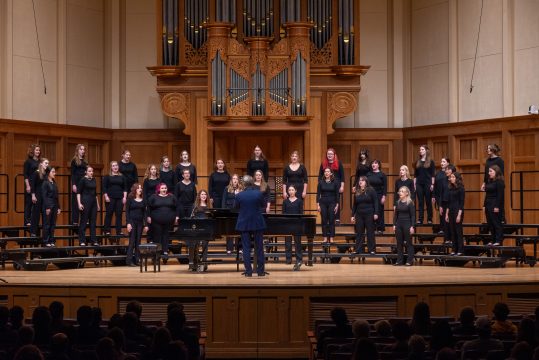On Friday, Oct. 6 at 7:30 p.m. in the Chapel, Lawrence University’s prolific choirs graced the stage for their first of many concerts throughout the year. I always deeply admire the work these choirs do, especially for this first fall concert. After only four weeks of rehearsals, they each performed three to four profound pieces completely memorized.
Viking Chorale, a choir open to every Lawrence student and conducted by Associate Professor and Co-director of Choral Studies Dr. Stephen Sieck, sported an incredibly versatile yet unabashedly love-ridden set to ignite the show. Their community-focused rehearsals were manifested wonderfully not only through their pieces, but their stage presence. The commitment the singers attuned to every piece translated even to my spot in the back of the Chapel.
They kicked off with “Show Us How to Love” by Mark A. Miller, with the baritone voices serenading against junior Kai Frueh’s arpeggiated piano accompaniment. The entire arrangement paralleled the storms that brewed outside — sweeping autumnal winds and uncertain skies. Occasional breaks in the instrumentation allowed the piece to climax even in its quaint introspection.
The storminess continued in their next piece, “Refuge,” by Elaine Hagenberg. The piano here jittered much more erratically, orbiting junior Nick Chrisman’s cello. His performance acted as a ray of light against the otherwise unsteady themes in the lyrical content: “If I can sing / I still am free.” Fourth-year Addison Littlefield’s solo similarly provided a brief release from the tension the choir weaved underneath.
To end their set, Viking Chorale performed an arrangement of “Amazing Grace” by Keith McCutchen, bridging choral and gospel influences into a particularly warm piece. Again, I was reminded of the sense of community this ensemble boasted. Between exciting modulations, unexpected resolutions and moments of massive choral harmonies, they smiled at each other, swaying to Dr. Sieck’s effusive conducting from behind the keys.
At this point in the concert, I was reminded of my place within the audience, yet still felt connected to the action onstage. Viking Chorale’s joy emanated across the Chapel even after their set, carrying over into Cantala’s performance. Directed by Professor of Music and Co-director of Choral Studies Dr. Philip A. Swan, Cantala’s concise and unified sound never failed to impress me. Whereas Viking Chorale embraced each singer’s individuality, Cantala unified their sound to reach a similar level of togetherness.

They began with a piece largely in unison, entitled “Psalm 47: Lam’natzeiach Livnei Koraach Mizmor” by Saul Irving Glick. Against an odd time signature, the singers bounced between sharp vocal passages and legato arches that showcased their entire range as treble vocalists. The piece demonstrated exactly what Cantala aimed for: concise unity.
“Antigua Canción” by Kirstina Rasmussen Collins again electrified the ensemble’s key tenets of wholeness. What I was especially astounded by with this piece was the dynamic call and response between different vocal parts, swelling and echoing against an especially ornate piano performance from sophomore Nhi H. Quach. At the key change, the tone vaulted into air, ending on a bittersweet note: “this song / that is singing / and crying at once.”
More poetic lyrics sprouted in the music of “Threads of Joy” by Tim Brent and Amanda Quist. Its unaccompanied arrangement allowed many fantastic soloists to take the reins, waxing and waning between strict tempos and fluid passages. Every rush of forte sounded like a string section: Cantala’s brightness led to an orchestral and all-encompassing effect with this piece.
To end their set, Cantala performed “Nothing Short of Grace” by Joan Szymko, which featured canonical passages rather than homophony. They navigated the music intricately, empowering the audience to keep going even in the face of hardship. I appreciated the simple choreography that mimicked the lyrical content of taking a step forward; the piece’s brevity bookended their set with hope.
The last ensemble was Concert Choir, again conducted by Dr. Sieck. This specific ensemble I loved for their constant innovation and willingness to masterfully perform both contemporary and archaic pieces, all while maintaining a lush choral sound. For this night’s set, all of their songs were unaccompanied, a feat that should not go unacknowledged.
Their opening piece, “This Sky” by Carlos Cordero, exploded immediately into complex harmonies. I was captivated by the tense dialectics this piece employed: percussive yet melodic, discordant yet paradisal, unsettled yet serene. It kept evolving into unexpected modulations, ascending like the “wingedness” Dr. Sieck said he aimed to capture with the performance. While dynamic, Concert Choir maintained a steady composure that tempered the unpredictability.
As a stabilizer, the much more unhurried “Super Flumina Babylonis” by Giovanni Pierluigi da Palestrina grounded their set. Its mourning and wayfaring passages in minor keys contrasted with brief modulations to major, losing and gaining hope in the same breath. I especially took note of how cathartic this piece was for the singers. With the performers’ harrowingly poignant expressions and the unresolved cadence lingering at the end, this piece floored me and left me wanting more.
“Antara,” meaning between, by Tracy Wong, was Concert Choir’s final piece and the closing performance of the night. Like “This Sky,” it jittered precisely, soaring and constantly contrasting between percussive and brassy melodic choruses. The dynamics ripened every sustained note, layering infinitely and never stopping to descend. It was an apt commentary on embracing discomfort in times of conflict, as well as a great closer.
Walking out of the Chapel that night, I reveled in how different each of these choral ensembles performed. They celebrated their individuality and unity unabashedly, each recognizing their place on that stage. Choir, for that reason, is truly a unique setting: one that inhabits the liminality of self and group.
